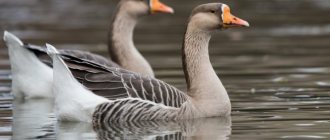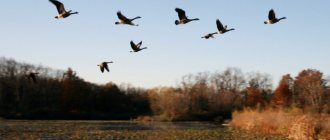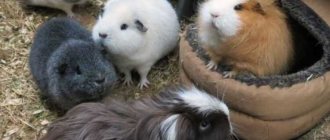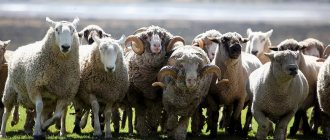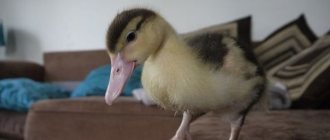Among poultry, geese occupy second place after chickens. Birds with webbed feet are unpretentious: even novice poultry farmers can breed geese at home.
Geese are raised to produce tasty soft meat, liver, eggs, and soft down. Before you start raising this poultry, you need to think about choosing a breed.
Some species can be aggressive and need to be tamed before 6 weeks of age. The owner must visit the goslings several times a day so that his charges know him by sight.
Breed selection criteria
Geese breeds are quite diverse.
When deducing them, we took into account:
- Productivity, that is, the amount of meat produced;
- Unpretentiousness;
- Disease resistance;
- Quality of feather and down;
- Egg production;
For breeding geese at home, bird size and rapid growth are important.
Well-known breeds for home raising include:
- Large gray. This variety is used to produce meat, liver, and eggs. Birds can do without a pond and are characterized by rapid growth. In 2 months, young goslings gain about 5 kg. The goose hatches eggs well and is attentive to the chicks. She brings up to 20 eggs per year. The weight of an adult goose reaches 8 kg.
- An ancient Russian breed is the Kholmogory. Raised for meat. Geese of this color acclimatize well and are distinguished by their longevity (they live up to 17 years). The weight of an adult gander reaches 12 kg. The goose lays 30 eggs annually. A disadvantage of the breed is considered to be late puberty.
- Toulouse geese have a calm disposition and are not difficult to keep. The impressive birds are large in size and quite weighty. A gander will pull 10 kg, a female will pull 6 kg. Lays 30 eggs per year. The French goose can live without a body of water, but water is required during breeding. The breed is valued for the quality of its meat and liver.
- Italian geese are very beautiful, love warmth, and need cleanliness and care. Meat and liver have high taste qualities. The goose brings up to 90 eggs per year.
Feather production
In poultry farming, goose down and feathers are extracted for the production of bedding. The most valuable product is down, and then feathers. Most commercial products use a combination of down and fine feathers. The more fluff is used, the higher the quality and price of the product.
To obtain feathers and down when slaughtering geese, poultry farmers typically use a container of hot water (60°C to 68°C for one to three minutes). The coarse feathers are then plucked out by hand and the rest are removed either with a plucking machine or by hand. After this, the feathers are dried and sorted.
Down and feathers from live geese are usually collected when the geese are nine to ten weeks old and have moulted naturally. Feathers can be collected from growing geese every six weeks, which coincides with the time of each subsequent molt. All breeds are suitable for plucking, but white plumage is more valuable.
How to breed geese?
A flock of geese is replenished with young animals in two ways:
- With the help of a hen who lays eggs for hatching.
- An incubator is used.
Breeding chicks by a hen
This method is preferable because it is more natural. One goose hatches no more than 14 eggs, as they are large.
When incubating, the hen's body should completely cover the eggs.
What you need to know:
- Comfort. Comfortable conditions are required for the hen. A spacious nest is located in a dry, well-ventilated room without drafts. If there are several hens, it is better to separate the nests with a partition. It is better to keep hens separately from the rest of the flock. Other females should not sit on incubated eggs.
- Dry and clean. If an egg accidentally breaks in a hen's nest, it is immediately removed and the rest is wiped. The litter is replaced with dry litter.
- The hen turns the eggs herself to ensure even heating. She goes to eat and drink on her own and returns to the nest. Only if the goose is hatching eggs for the first time can it linger, then it needs to be returned to its place.
- The water in the drinking bowl must be clean and changed at least once a day. Hens should be fed high-quality grain.
The chicks appear on the 28th day. The very first ones are placed in a box under a lamp. After the entire brood has emerged, the chicks remain with the goose. In the evening, you can quietly add hatchery goslings to the brood. They will appreciate maternal care.
Incubator
Raising goslings at home in an incubator is more difficult than raising chickens. Geese eggs contain fat and are larger. Therefore, when chicks hatch from 70% of the eggs in the set, the result is considered good.
Peculiarities:
- Fresh eggs are laid, no older than 10 days.
- Before laying, the incubator is heated at 39°.
- Eggs of ideally correct shape are selected.
- You cannot wash eggs before laying them. They can be wiped with hydrogen peroxide or weak potassium permanganate.
- The first 5 hours provide a temperature of 38°, then 37.8°. The last two days 37.5°.
- To ensure uniform heating, the eggs are turned 8 times a day.
- The incubator is ventilated periodically.
Existing types of feed
Conventionally, food for geese is divided into two types: natural and human-prepared. The first type is considered the most useful, since the bird receives all the vitamins and microelements. Natural food consists of forbs, small branches and foliage of trees. In the pond, geese catch algae and fish fry.
Human-prepared food is more aimed at fattening geese and increasing their weight, but without it the bird is also unable to survive. It is divided into 4 groups:
- Dry food consists of ground cereal grains, corn, and it can be a mixture of several types. Such food is considered nutritious, but does not contribute to rapid weight gain. Dry food is given when goslings are growing up or during the unproductive period.
- Wet food is the same as dry mixtures, only generously moistened with water. Additionally add chopped herbs and vegetables. Moistened food is better digested by the stomachs of geese and does not irritate the mucous membrane.
Important! To obtain wet food, 1 kg of dry grain mixture is diluted with 1.5 liters of water.
For small goslings you can use bowls or small basins
- Combined feed is often called compound feed, and by this we mean a dry mixture of crushed grains of different crops with mineral and vitamin supplements. Partly correct, but not entirely. Combined food consists of a mixture of dry and wet food with various additives that stimulate the growth and development of geese.
- Fertilizers cannot be completely classified as food. They consist of premixes, complexes of vitamins, minerals, and growth stimulants. Their main direction is the development of bones and muscles of the bird. Fertilizers are considered additives to the main feed; they are introduced in limited quantities.
Knowing the main types of food, it will be easier for the poultry farmer to understand how to feed little goslings at different stages of life.
Attention! The goose is considered a waterfowl; water should be present in its diet more often than food, that is, constantly.
Contents of goslings
If the chicks are kept without a brood hen, the temperature in the room must be maintained, changing as the goslings grow:
- 1-3 days -28°-30°;
- 3-5 days -25°-28°;
- 6-7 days -23°-25°;
- 8-10 days - no more than 24°;
- 10 – 15 days – 20°-22°;
- 15 -20 day - 18°-20°.
Keeping in a warm room can last up to 30 days depending on the season and weather.
Weak individuals are kept separately and given enhanced nutrition. If the gosling falls, you need to help him get up on his legs; he should not lie on his back for a long time.
The premises are equipped according to the following rules:
- Floor with bedding.
- Lamp with lampshade for uniform heating.
- The feeder and drinking bowl are arranged so that the goslings do not get dirty.
- 24-hour lighting of the poultry house is provided.
After 20 days, the goslings live with the young, no more than two birds per 1 sq.m. Waterfowl geese love water. The presence of a pond improves the quality of life of geese.
Correct diet for young animals
At each stage of life, goslings develop a digestive system. Taking into account the natural cycle, the poultry farmer prepares the diet:
When feeding grain crops - wheat, barley, millet, the products must contain a minimum amount of harmful impurities; 0.1% chaff, 0.25% cockle and 0.05% ergot are allowed.
- Newborn chicks are taught to eat food as soon as their down dries. A chopped boiled egg is poured into a small saucer. To prevent the yolk from sticking in the esophagus, it is moistened with plenty of water. Chicks are given eggs 8 times a day with a 2-hour break, but not more than 20 g per head per day. The regimen is considered optimal and promotes survival of up to 95% of young animals.
- For day-old goslings, the eight-meal diet is maintained, but the amount of feed per head is increased to 35 g. Mash is made from the egg, adding ground corn, millet or bran. You can soften the bread in water and crumble it, but only a small amount. The chicks are given drinking bowls; they can drink an unlimited amount of water, but it is heated to room temperature.
Attention! You cannot feed day-old goslings cottage cheese or sour milk due to the possibility of digestive system disorders.
Feeding chicks from 3 days
Three-day-old chicks are fed without changing the schedule or norm. However, the diet is enriched with protein foods. Chopped greens, carrots, and peas are added to the chopped egg. From the third day of life, cottage cheese is gradually introduced into the diet. The frequency of feeding is reduced to 6-7 times. When feeding chicks in winter, it is impossible to find fresh grass. Greens are replaced with boiled grated vegetables or root vegetables. Water is still provided in unlimited quantities. To speed up growth, add glucose to the drink and make a 5% solution. From an early age, drugs are periodically introduced into the water to prevent diseases, but the dose is prescribed by a veterinarian.
See also: Linda geese breed: features of keeping and rearing
Feeding from 7 to 21 days
Week-old goslings begin to gain weight, and the body requires an increase in protein feed. Chopped legumes are added to the mash: beans, soybeans, peas. They increase the norm; now they give up to 45 g of feed per head. Additives include meat and bone meal, rich in protein and calcium. The boiled egg is gradually removed from the diet and replaced with cereals and ground corn. Grated vegetables and root vegetables are still fed, fish oil and mineral complexes are added. From the 10th day of life, goslings are fed 4-5 times a day and are given store-bought feed with additives.
For two-week-old chicks, the feeding schedule is maintained, but the portion is increased to 80 g per day. Young animals are rapidly gaining weight; food and water are needed in sufficient quantities to moderate their appetite. Geese are given wet mash, but it should not be sticky. Such food is heavy on the stomach and causes upset.
Feeding goslings after 21 days
For three-week-old geese, the amount of feed per head reaches 170 g. The diet remains the same, but the amount of greens is increased. Chopped vegetables are mixed with cereals, bran is added. To quickly gain body weight, give sunflower cake no more than 25 g per head. The feeding schedule is similarly maintained 4 to 5 times a day.
Month-old goslings graze the grass to their heart's content. If there is no access to pasture, green food is given in the enclosure, distributed at 350 g per head 3 times a day. Grated vegetables are added to the grass, and the rate of grain mixtures is reduced to 70 g per day, otherwise obesity will begin.
Access to a pond affects the better growth and development of geese. Food obtained in water is distinguished by its calorie and nutritional value. However, in order to obtain natural food, the bird spends a lot of energy. To replenish calories, the norm of grain mixtures is increased, but grass is not given. The geese themselves will eat plenty of it by the pond.
When a poultry farmer knows how to feed small goslings and growing livestock, he is able to regulate even the quality of meat. It depends on the diet whether it will be tender, soft or completely fat. Proper feeding in the future will affect egg production, fertilization and the production of offspring.
Feeding the chicks
Immediately after drying, the chicks are fed. In the first five days, meals are provided every 2 hours.
Best suited:
- Mash hard-boiled eggs with water and crushed wheat.
- Ground oatmeal and peas, soaked in water.
- Bran with herbs are added: nettle, clover.
- Sometimes the mash is made with yogurt or cottage cheese.
- Fish oil and yeast must be present.
- Vitamins and mineral supplements are required.
You should not give sticky mixtures to prevent the nasal passages from becoming clogged. When clogged, inflammation develops.
Introductory Description
It cannot be said that breeding is burdened with many nuances. Geese are not fussy about food and care; the main thing is that their home is always dry and warm. Speaking about this area of business, today it is the most profitable business.
There are several features:
- Geese quickly gain weight and grow.
- They survive cold well and are not susceptible to serious diseases with regular care.
- A large specimen will bring 4 kg of meat to the owner.
- They have high sensitivity and intelligence. The instinct is well developed; they can predict changes in the weather or impending danger. They are quite vindictive, which household members should know about.
- The main period is from the birthday to the month. It is during this period of time that you will have to gain strength and patience so that the gosling can grow into a large and healthy bird.
To avoid getting into an unpleasant situation, there are several rules to follow:
- It is strictly forbidden to purchase small animals on the market from strangers. Most often they are kept in minimal conditions, and 90% of the brood die within the first week in their new home.
- Activity - a healthy bird, even at a young age, reacts well to extraneous sounds and moves quickly.
- If the goslings are not curious and noisy, it is not worth buying.
At the first stage, this information is enough to make a decision. Information on the care and maintenance of poultry goslings can be found below.
Poultry house
Year-round breeding of geese is impossible without a convenient poultry house. Birds should feel comfortable and live in safety. For each adult you need to have 1 sq. m area. Crowding and darkness cause egg pecking and feather loss. The site for the poultry house is chosen to be dry and level.
When building an enclosure:
- Wood should be preferred.
- The inner surface of the wall should be smooth and easy to clean.
- The walls and ceiling are whitewashed.
- The roof is insulated.
- The windows should be quite large and reinforced for safety.
- A solarium for walking is being built.
- Places for feeding and drinking water are provided. The water in the drinking bowls must be fresh and in sufficient quantities.
- Ash baths are installed in the enclosure or solarium, bathing in which destroys parasites.
- The number of nests is constructed in accordance with the number of females: one nest for two individuals.
Geese tolerate cold well, but the temperature should not fall below +5°. There should be no drafts in the goose house, because geese cannot stand them.
An exhaust hood is required to maintain moisture levels. Natural light is not enough; electricity is a must. The lamps are suspended at a height of 2 m, 60 W per 6 sq. m. m. Lighting should be moderate and uniform.
Geese need a walk. If there is no body of water nearby, install a container of water for swimming.
Disease Prevention
Instead of treating a disease, it is better to prevent it in advance, especially since some infectious diseases can cause mass mortality of birds.
Experts recommend taking the following preventive measures against various diseases:
- Comply with sanitary and hygienic standards in the poultry house - such as maintaining cleanliness, disinfection of the poultry room, nests, and all equipment. Replace bedding regularly.
- Make sure that there is no high humidity or drafts in the goose barn.
- Regularly clean and disinfect walking areas.
- Carry out sanitary and epidemiological control of water bodies.
- Carry out the necessary vaccinations.
- Keep small chicks separately from adults.
- Regularly carry out deworming against parasites.
- Include greens and succulent food in the diet, as well as the necessary complex of vitamins and minerals.
- Balance the bird's diet; Ensure that the food is of high quality and fresh.
- To prevent the occurrence of infection, add coccidiostats to the geese's feed once a month during the warm period.
- If serious infectious diseases are detected, transfer sick individuals to quarantine. The same thing applies to suspected illness. Birds that are too affected by the disease must be slaughtered. Be sure to contact your veterinarian.
Did you know? Owners of geese often complain about the noise of these birds, but it was this quality that once saved Rome. The historical work of the ancient historian Titus Livy, “History from the Foundation of the City,” tells how in the 5th century BC the Gauls tried to capture the Capitoline fortress at night, but the geese, noticing them, made a noise and woke up the defenders of the fortress.
So, keeping geese is a troublesome task, but it pays off, especially if there is a pond or grazing area nearby. If you get down to business seriously, you can create a thriving business from scratch.
Differences between summer and winter feeding
The diet of goose varies depending on the season. In summer, geese eat green grass; in winter, it needs to be replaced with silage. Feeding geese in the summer is cheaper and easier.
It is enough to feed wet and grain food once a day. In winter, this must be done 3 times. Root vegetables are needed in winter. A winter replacement for green grass is pine or spruce needles ground in a meat grinder.
The period of raising geese should not be very long, because the quality of the meat deteriorates. Usually 4 months are enough for the goose to gain sufficient weight.
Keeping geese requires expense and labor, but brings good results.
Construction of a gooseneck
Before building a gooseneck, you need to look to see if an old barn or other similar room in the country is suitable for it. The main parameters to consider are the following:
- High foundation for protection against rodents.
- The walls are about 2 meters high.
- Slate or roofing felt as a roof.
- If necessary, the inside of the room is insulated with special materials.
- It is better to make windows facing south.
- Inside there are several rooms for geese of different ages.
The presence of nests for females is important. They can be made from simple wooden boxes with a removable tray to make removing the eggs easier.
Geese love ponds in summer
The goose barn must have feeders, drinkers, nests, a special hole for passage and a container for water procedures.

